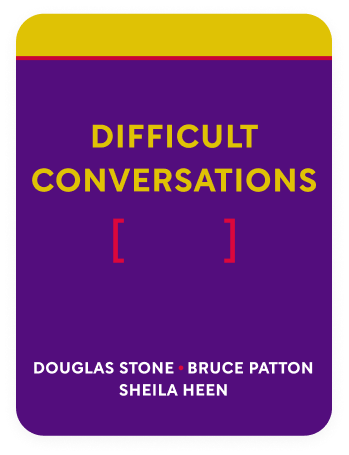

This article is an excerpt from the Shortform book guide to "Difficult Conversations" by Douglas Stone, Bruce Patton, Sheila Heen. Shortform has the world's best summaries and analyses of books you should be reading.
Like this article? Sign up for a free trial here .
How would you define effective listening? What do you think it entails?
According to the authors of Difficult Conversations, the key to effective listening is to be genuinely curious. No matter how good you might be at doing the things listed on the effective listening checklist, people can usually tell whether it’s authentic or not.
Here is how you can master effective listening.
Effective Listening: Making Someone Feel Heard
Humans want to be heard. We want to feel like someone else cares about us enough to listen. Effective listening is a vital skill for difficult conversations. Not only does it help us understand the other person better, but it helps them understand us better as well.
Listening can transform a difficult conversation into a learning conversation. It requires us to be curious about the other person, to reframe our purpose from persuading the other person to learning about them. Effective listening involves asking questions to better understand the other person and acknowledge the other person’s feelings.
One of the most common complaints the authors hear about difficult conversations is that the other person isn’t listening. This really means we need to be better at listening first. When we feel others aren’t listening to us, we tell ourselves they’re stubborn, don’t care what we have to say, or don’t understand it. So we often double-down, repeat ourselves, and talk over the other person.
The reality is that people stop listening when they don’t feel heard. If we feel like someone isn’t listening to us, they probably feel the same way about us. The way to get someone to listen to you is to put a genuine, concerted effort into making sure they feel heard first.
Making Someone Feel Heard
The goal in a difficult conversation is to shift our mentality from assuming we already understand someone to wanting to understand them better.
One major thing that prevents us from doing that is our inner voice — what we’re thinking but not saying. When we focus on our inner voice, we’re at best only half-listening to the other person.
Typically, your inner voice is thinking about the 3 conversations we covered – What Happened, Feelings, and Identity. Listening to your inner voice will start to give you answers and questions to explore in those 3 areas.
There are two things that can help you start managing your inner voice:
1. Negotiate your brain back to curiosity. You can start to change your inner voice by reinforcing the right thing. Remind yourself that it’s a delusional assumption to think you already understand someone else. Remind yourself of a time you thought you were right, but discovered you’d been wrong. Remind yourself that other people are just as complex as you: if you wouldn’t want someone else assuming they understood you without listening, don’t do it to someone else.
2. If your inner voice is too strong, talk instead of listen. Sometimes our feelings are too overwhelming to listen. When this happens, first let the other person know that you want to listen to them, but you’re having a hard time focusing. You can try giving a sound bite of what’s preoccupying your mind, to let the other person know where you’re at right now: “I want to hear about your perspective, but I’m feeling defensive right now.” Hopefully saying this might quiet down your defensiveness for a moment, and you can let the other person finish what they have to say and then come back to your feelings.
Or you might decide that you can’t listen or talk right now because you’re too overwhelmed. Express that this conversation is important to you, and you want to come back to it when you feel better prepared to have it.
Tips for Effective Listening
Effective listening requires 3 skills that can be learned by anyone. These 3 skills are interconnected skills centered on whether you’re really listening or whether you’re trying to prove a point.
Skill #1: Ask Questions with the Goal of Learning
If you’re not sure about your goal, ask yourself why you want to ask the question. If your answer is anything other than “to learn about the other person,” it’s probably not a good question to ask.
Don’t ask questions that are really statements. Often, we want to express a statement in a difficult conversation, and we mistakenly think it’s more polite to ask it as a question instead. This usually comes off snide or passive-aggressive. Instead of hearing your feelings or opinions, the other person will most likely focus on the attack and get defensive.
- (Shortform example: “Are you going to wear that shirt to the interview?” is a question that should be a statement, since it obviously conceals an opinion about the shirt. “I don’t think that shirt looks very professional” is the statement that should be expressed.)
Don’t ask questions to prove the other person wrong. Questions you ask with the intention of proving someone wrong aren’t focused on learning, they’re focused on persuading or humiliating someone else. They usually serve as traps for the other person — and trapping them into an answer isn’t aligned with the goal of learning. Again, the outcome will be defensiveness.
- “If you’re a good salesman, then why did Kate close the deal when you couldn’t?” This isn’t a question interested in learning, it’s a question interested in proving a point — that you aren’t as good a salesman as you think you are, since Kate outsold you.
Ask open-ended questions. You’ll get more information with these than with yes or no questions, or multiple-choice questions. Again, the goal should be to learn about the other person — you can only do that by getting them to talk. Use phrases like “tell me more about…” or “help me better understand…” to get the other person talking.
Ask for more specific information, especially on anything you’re confused about. Questions like, “What leads you to say that?” or “Can you give me an example?” or “How would that work?” can be helpful.
Ask them about the 3 Conversations: What Happened, Feelings, and Identity conversations.
- What Happened: “Can you tell me more about why you see it that way?” and “What impact have my actions had on you?”
- Feelings: “How are you feeling about this?”
- Identity: “Can you tell me why that’s important to you?”
Give them the option to not answer. Questions should be invitations, not demands. The other person should be able to refuse to answer your questions without any punishment. It builds trust if someone declines to answer a question and you show that it’s okay. People often feel freer to answer questions if they feel they have the option not to.
Skill #2: Paraphrase Their Responses
Paraphrasing someone’s response means expressing, in your own words, your understanding of what they’re saying.
Paraphrasing helps you double-check whether your understanding is correct, and gives the other person an opportunity to clarify if you’re misunderstanding something. This also confirms for the other person that you’ve heard them, and are trying to understand them.
We usually repeat ourselves because we’re not sure if someone’s understood us — once we know they have, we can focus on listening to them in return. If you notice the other person repeating themselves, it probably means they don’t feel understood yet.
Skill #3: Acknowledge Their Feelings
Feelings desperately want to be acknowledged, and acknowledging someone else’s feelings requires empathy. Empathy is “a journey with a direction but no destination.” Empathy requires us to move beyond observing someone from the outside, and imagine what it would be like to be them on the inside.
It won’t be perfect — we’re all too complex to ever be totally understood by someone who isn’t us. But psychologists discovered that it’s more important to feel like someone is trying to empathize with us than believing they’ve done it successfully.
Acknowledgement is about showing the other person that you’re working to understand their feelings. Usually, this step requires us to paraphrase the things the other person isn’t saying.
- (Shortform example: If your partner expresses annoyance that you forgot about the dinner plans you made, some of the unspoken feelings in this expression might be that they’re hurt you don’t prioritize them, or that they’re worried it means you don’t want to see them.)
Another way to think of this is: feelings usually come with a number of unasked questions. Even an expression of anger that seems focused on an event probably has a silent question at its heart. 3 examples of unasked questions are:
- Is it okay that I’m feeling this?
- Do you care about my feelings?
- Do you care about me?
Acknowledging people’s feelings gives a resounding yes to each of those questions. This helps them feel safer and ready to move forward in the conversation.
- For example: If your friend is unhappy with a mistake you’ve made, “It won’t happen again” might respond to the situation, but not to your friend’s feelings. “It sounds like this was really important to you,” is an acknowledgement of their feelings about the situation.
Verbal responses aren’t always necessary — a nod or a look might be enough. But it’s incredibly important to acknowledge feelings before you try to solve the problem. Order matters. Most of us skip straight to offering solutions because we think the issue is that there’s a problem that needs to be fixed. Usually, people want their feelings heard first and foremost.
Remember: acknowledgment is not agreement. You might not agree with what the other person is feeling, but you should be able to acknowledge that their feelings are still important. You’ll never get through a difficult conversation if you don’t believe the other person’s feelings are important — it will most likely turn into an argument.

———End of Preview———
Like what you just read? Read the rest of the world's best book summary and analysis of Douglas Stone, Bruce Patton, Sheila Heen's "Difficult Conversations" at Shortform .
Here's what you'll find in our full Difficult Conversations summary :
- Why healthy relationships need difficult conversations
- The 3 conversations that happen within each difficult conversation
- How difficult conversations go wrong and what to do about it






